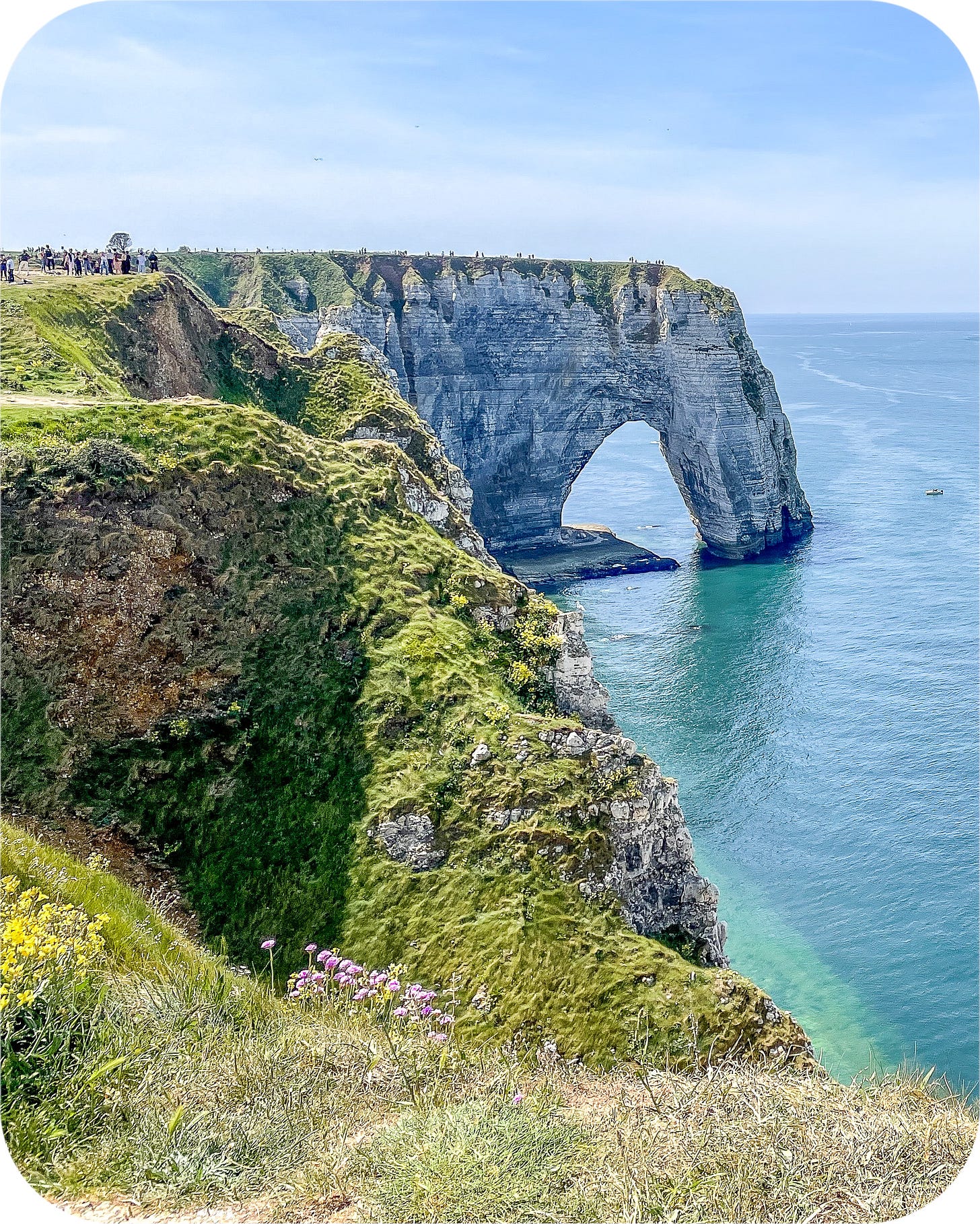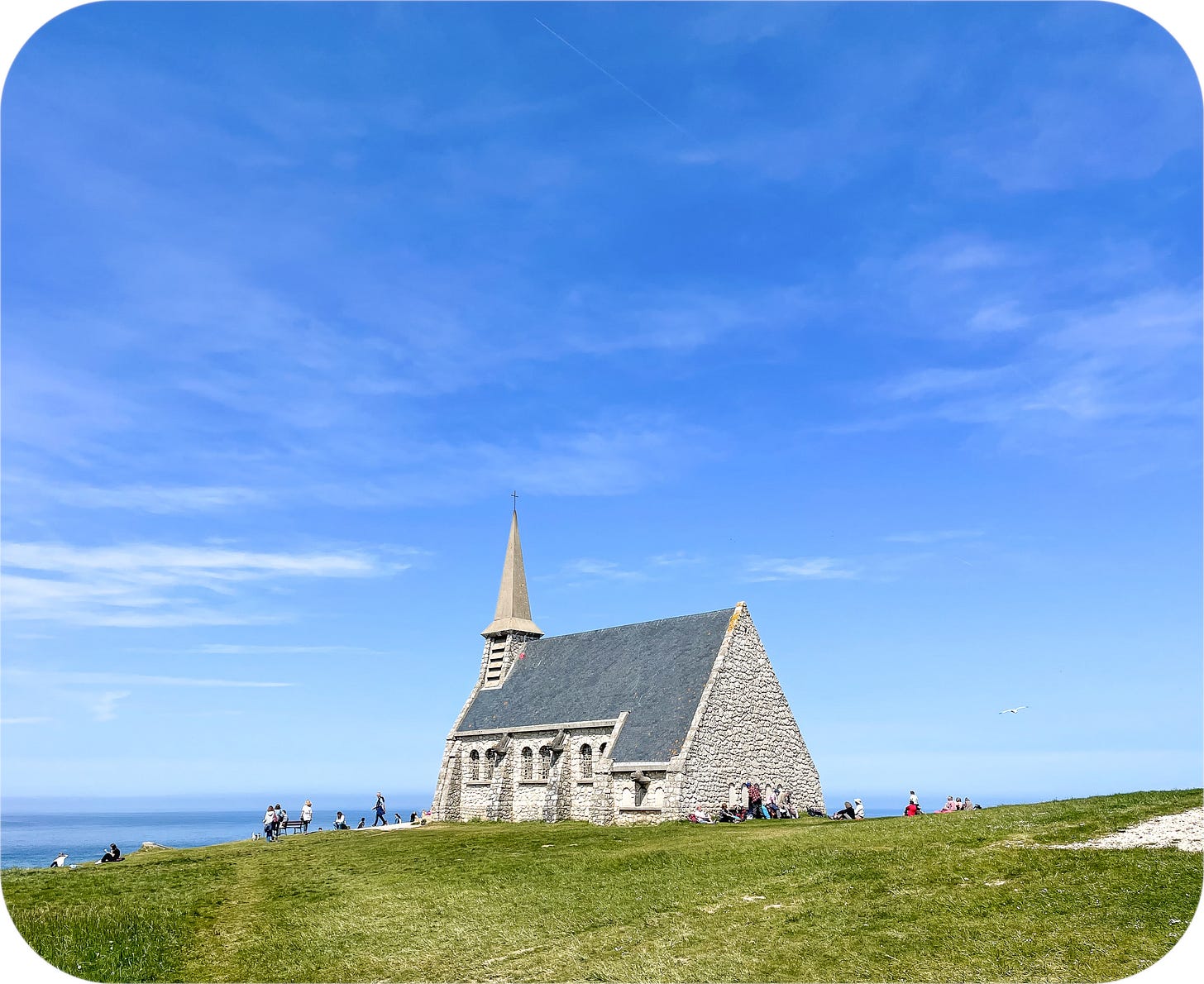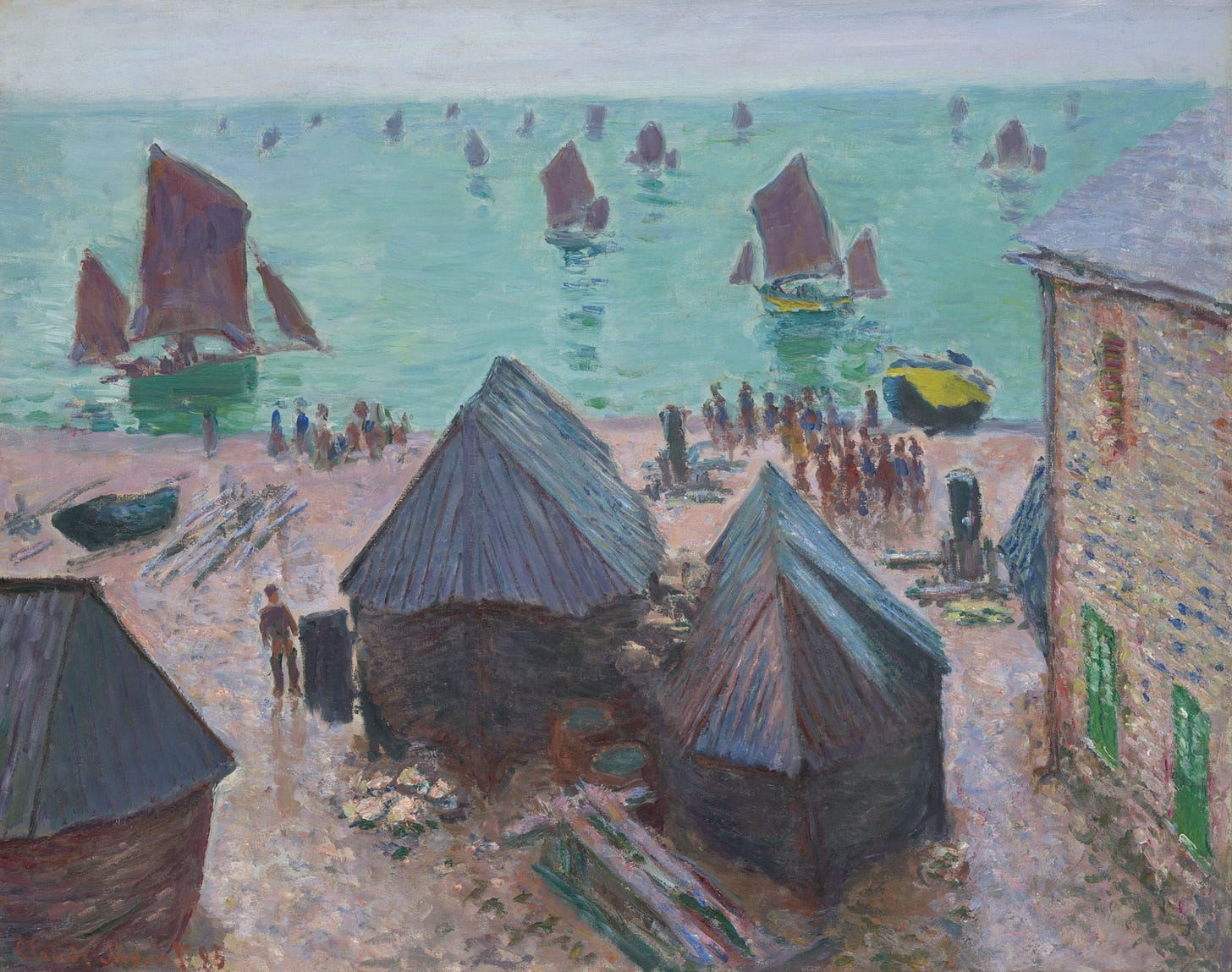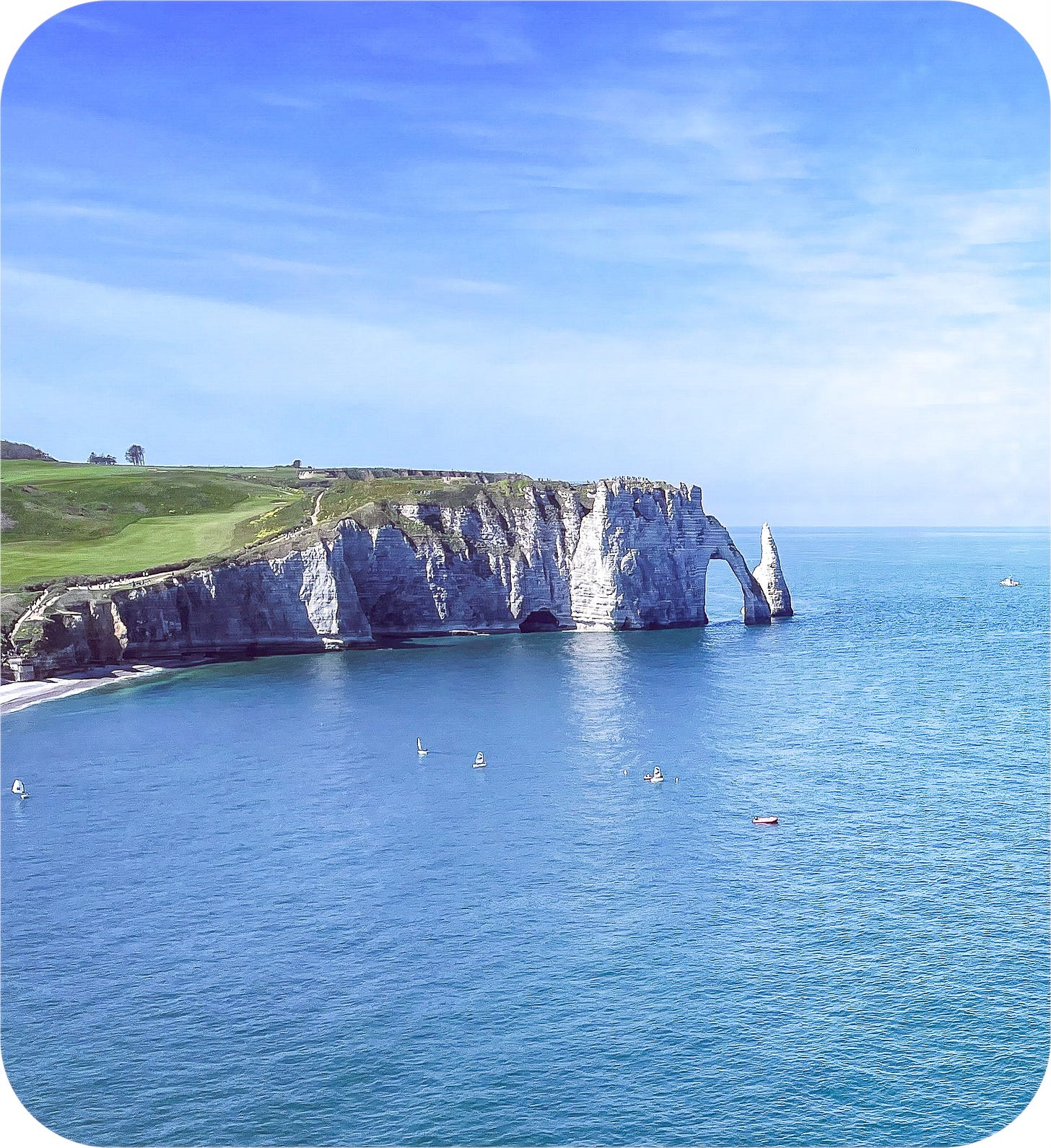Étretat
In which I uncover the story of Claude Monet's stay in this seaside town, and walk the cliffs that inspired him.
It is beautiful here (in Etretat), my friend; every day I discover even more beautiful things. It is intoxicating me, and I want to paint it all - my head is bursting…I want to fight, scratch it off, start again, because I start to see and understand.
-Claude Monet, 1864
{Étretat, France}
Claude Monet was born in Paris, but grew up in Le Havre, in Normandy, in northern France. He visited the nearby coastal town of Étretat for the first time in 1864. He was 24 years old, and wrote about the town in a letter to his fellow artist, Frédéric Bazille, “It is beautiful here, my friend; every day I discover even more beautiful things.”
A man after my own heart.
He continues, “It is intoxicating me, and I want to paint it all - my head is bursting…”
The small town of Étretat is sandwiched between two large cliffs. It is the cliffs that are the star of the show - the cliff to the north of town is called the Falaise d’Aval, and the small arch at the base is called the Porte d’Aval. The cliff to the south is called the Falaise d’Amont, and the large arch that looks like an elephant’s trunk at the point of it is called the Porte d’Amont. Right off of this cliff is a large, pointy rock formation called l’Aiguillle, or The Needle. A little bit further south along the coast is the largest arch of all, La Manneporte.
I’d like to tell you that I’m pondering the paintings of Monet as I walk along the cliffs at Étretat, but it would be a lie. I can say with all honesty that I would have never come to Étretat had it not been for Monet, or the many other artists who’ve painted here - would likely have never ever heard of this small town.
But today is one of those perfect spring days, and honestly the Impressionists are not on my mind - except when I stop to think that no painting that I’ve ever seen has prepared me for the beauty of these white cliffs.
The English Channel is crystal clear as it washes over the rocky beach, but as I make the long and slow walk to the top of the cliffs the water’s blue grows deeper and deeper as the brilliant spring sky reflects off of the calm waters, intensifying the hue.
As I reach the top the blue becomes endless as sky and water meld. Seagulls glide and swirl gracefully on the gentle breeze. Sitting in the fresh green grass surrounded by wildflowers, I think to myself that if there is in fact a heaven, it must look just like this.
The view must have been very different when Monet came to stay in January of 1882, setting up his studio at the Hotel Blanquet near the beach. The hotel advertised itself as “The Artist’s Rendez-Vous”, and in January - when the rest of the town was deserted - the prices were right for the financially struggling Monet. It had been a difficult few years - his first wife, Camille, had died of ovarian cancer in 1879, and his paintings were not selling as well as he would have liked, despite showing in the Impressionist exhibitions and at Paul Durand-Ruel’s gallery in Paris.
He had fallen in love with Alice Hoschedé, the wife of his friend and patron, Ernest Hoschedé, and his small family was sharing a home with the Hoschedés in Vetheuil, just north of Paris on the Seine. Alice was devoted to Monet, but due to financial woes was finding it difficult to split from her husband.
Monet, under great financial pressure to support his family, retreated to Étretat - to complete paintings for Durand-Ruel in Paris, while he waited for word from Alice about her plans for the future.
The cliffs at Étretat are blindingly white and majestic - the stuff of painter’s dreams. Monet, however, sends paintings to Paris of the shore, and the beach, and the boats docked nearby, waiting to take fisherman out to sea.
Durand-Ruel is not impressed. He wants paintings that he can sell - the kind of paintings that people want to hang over the mantlepiece. He, of course, wants paintings of the beautiful cliffs…and also, it would be nice if they were finished. Enough of these quick sketches.
It is certainly bold of me to paint the cliffs of Etretat after Courbet, who did it admirably, but I will try to do it differently.
-Cluade Monet, 1882
Monet likes to paint what he likes to paint…but he also wants to earn money. His relationship with Alice and their financial uncertainty weigh on his mind. When the weather allows, he takes his easel to the beach, and paints the cliffs. He writes to Alice, “It is certainly bold of me to paint the cliffs of Étretat after Courbet, who did it so admirably, but I will try to do it differently…”.
The drop to the rocky beaches below from the top of the cliffs at Étretat is about 300 feet, straight down. As I lounge in the grass, my heart races as people walk up to the edge of the cliffs with abandon. There are no guards here, no fences. College kids crawl along the top of outcroppings, seemingly unaware that one mis-step would lead to certain death. They are either braver than me, or more foolhardy.
There is danger on the beaches below, as well. Besides the main beach at Étretat, there are several periphery beaches - coves, really, that are difficult to access and much smaller. Sometimes, when the tide comes in, they disappear altogether. One cold afternoon, Monet managed to navigate the cliffs with his easel, canvases and paints, and was painting alone in a small cove. Concentrating, as ever, on his work, he didn’t notice the waves getting stronger behind him…until one exceptionally large wave washed over the cove, sweeping Monet out to sea, along with his canvases and easel. He wrote to Alice that he just managed to save his life by scrambling onto a passing boat - but all of his tools and work were lost.
In Paris one is too preoccupied by what one sees and what one hears…what I am doing here has, I think, the merit of not resembling anyone, because it is simply the expression of what I myself have experienced.
-Claude Monet, 1882
His friends in Paris sent replacements, of course, and when they arrive, Monet paints and paints and paints. And returns to Étretat in later years and paints some more. In all, over ninety of Monet’s paintings of Étretat survive.
The early 1880s are a pivotal time for Monet. After twenty years on the move, he finds a property on the Seine in Normandy in 1883, in a little town called Giverny. He spends the rest of his life there.
Alice marries him, but not for another ten years.
Paul Durand-Ruel takes his paintings - along with those of the other Impressionists - to exhibit in New York, and from there their reputation grows.
In the end (spoiler alert!) he does pretty well for himself.
After climbing the cliffs I have the worst, most over-priced salad of my life in a café in the little town by the sea. But that’s ok because there’s also wine, and seagulls far above, and the sea breeze, and the blue sea and the chalky white cliffs and the rocky beach. And who am I to complain about a salad when I’m so close to heaven?
















Hmmm, with all that talk of painters I am surprised there was no mention of the painting of Étretat by yours truly 😂🤣
Sigh! I could feel the ocean breeze and picture the white cliffs! What a wonderful way to wrap up my workday by visiting a beach town that inspired painters for years!